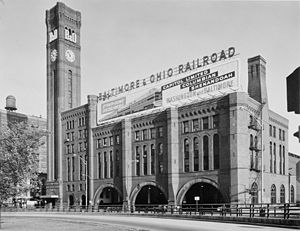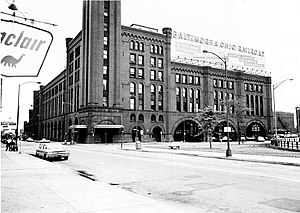The Pere Marquette Railway was a railroad that operated in the Great Lakes region of the United States and southern parts of Ontario in Canada. It had trackage in the states of Michigan, Ohio, Indiana, and the Canadian province of Ontario. Its primary connections included Buffalo; Toledo; and Chicago. The company was named after Jacques Marquette, a French Jesuit missionary who founded Michigan's first European settlement, Sault Ste Marie.

The Grand Trunk Western Railroad Company was an American subsidiary of the Grand Trunk Railway, later of the Canadian National Railway operating in Michigan, Illinois, Indiana, and Ohio. Since a corporate restructuring in 1971, the railroad has been under CN's subsidiary holding company, the Grand Trunk Corporation. Grand Trunk Western's routes are part of CN's Michigan Division. Its primary mainline between Chicago and Port Huron, Michigan serves as a connection between railroad interchanges in Chicago and rail lines in eastern Canada and the Northeastern United States. The railroad's extensive trackage in Detroit and across southern Michigan has made it an essential link for the automotive industry as a hauler of parts and automobiles from manufacturing plants.

Michigan Services are three Amtrak passenger rail routes connecting Chicago, Illinois with the Michigan cities of Grand Rapids, Port Huron, and Pontiac, and stations en route. The group falls under the Amtrak Midwest brand and is a component of the Midwest Regional Rail Initiative.

The Richard B. Ogilvie Transportation Center, on the site of the former Chicago and North Western Terminal, is a commuter rail terminal in downtown Chicago, Illinois. For the last century, this site has served as the primary terminal for the Chicago and North Western Railway and its successors Union Pacific and Metra. Intercity services had disappeared by the 1970s, but commuter services on the three ex-CNW mainlines, Metra's UP District lines, continue to terminate here. The tracks are elevated above street level. The old CNW terminal building was replaced in the mid 1980s with a modern skyscraper, the 500 West Madison Street building. The modern building occupies two square city blocks, bounded by Randolph Street and Madison Street to the north and south and by Canal Street and Clinton Street to the east and west. It is the second busiest rail station in Chicago, after nearby Union Station, the sixth-busiest railway station in North America, and the third-busiest station that exclusively serves commuter traffic.

The Michigan Central Railroad was originally chartered in 1832 to establish rail service between Detroit, Michigan, and St. Joseph, Michigan. The railroad later operated in the states of Michigan, Indiana, and Illinois in the United States and the province of Ontario in Canada. After about 1867 the railroad was controlled by the New York Central Railroad, which later became part of Penn Central and then Conrail. After the 1998 Conrail breakup, Norfolk Southern Railway now owns much of the former Michigan Central trackage.

A railroad car float or rail barge is a specialised form of lighter with railway tracks mounted on its deck used to move rolling stock across water obstacles, or to locations they could not otherwise go. An unpowered barge, it is towed by a tugboat or pushed by a towboat.

Central Station was an intercity passenger terminal in downtown Chicago, Illinois, at the southern end of Grant Park near Roosevelt Road and Michigan Avenue. Owned by the Illinois Central Railroad, it also served other companies via trackage rights. It opened in 1893, replacing Great Central Station, and closed in 1972 when Amtrak rerouted services to Union Station. The station building was demolished in 1974. It is now the site of a redevelopment called Central Station, Chicago.
The Baltimore and Ohio Chicago Terminal Railroad is a terminal railroad in the Chicago area, formerly giving various other companies access to (Chicago's) Grand Central Station. It also served to connect those railroads for freight transfers, and is now controlled by CSX Corporation, the successor to the Baltimore and Ohio Railroad.
The Porter Subdivision is a railroad line owned by CSX Transportation in the Chicago, Illinois, area. Formerly a part of the main line of the Michigan Central Railroad, it now connects CSX's former Baltimore and Ohio Railroad line and the Chicago Fort Wayne and Eastern Railroad from the east with the Indiana Harbor Belt Railroad towards Blue Island, Illinois.
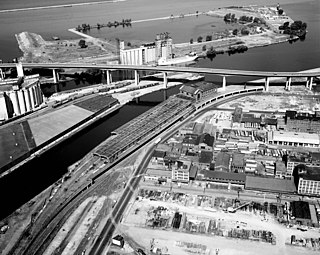
The Metro Rail Maintenance Yard or "South Park Terminal" houses Buffalo Metro Rail's cars in a train shed at the former Delaware, Lackawanna and Western Railroad terminal in the Cobblestone District of Buffalo, New York. The property is located at the southernmost fringe of the Central Business District. The station was built in 1917, and was designed to handle both steam trains and steamships. The storage and maintenance facility was converted to its present condition in 1982, following the demolition of the former main terminal concourse building "headhouse" of the DL&W Terminal in 1979.

The Grand Trunk Milwaukee Car Ferry Company was the Grand Trunk Western Railroad's subsidiary company operating its Lake Michigan railroad car ferry operations between Muskegon, Michigan, and Milwaukee, Wisconsin, from 1905 to 1978. Major railroad companies in Michigan used rail ferry vessels to transport rail cars across Lake Michigan from Michigan's western shore to eastern Wisconsin to avoid rail traffic congestion in Chicago.

Martin Luther King Jr. Plaza is the main passenger rail and intercity bus station of Toledo, Ohio.

The Pere Marquette is a passenger train operated by Amtrak as part of its Michigan Services on the 176-mile (283 km) route between Grand Rapids, Michigan, and Chicago, Illinois. It is funded in part by the Michigan Department of Transportation and is train 370 eastbound and train 371 westbound. The westbound train leaves Grand Rapids during the morning rush, and the eastbound train leaves Chicago after the afternoon rush, enabling same-day business travel between the two cities.
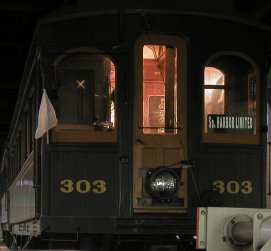
Cleveland has been and continues to be deeply rooted in railroad history.

The Union Depot is a former train station, located at 637 E. Michigan Avenue in Lansing, Michigan. It was listed on the National Register of Historic Places in 1995. Despite the union name, Grand Trunk Western trains stopped at a different station 1 mile away. Lake Shore and Michigan Southern Railway trains of the former Lansing Division stopped at another station a quarter mile away.

The Wabash Railroad was a Class I railroad that operated in the mid-central United States. It served a large area, including track in the states of Ohio, Indiana, Illinois, Iowa, Michigan, and Missouri and the province of Ontario. Its primary connections included Chicago, Illinois; Kansas City, Missouri; Detroit, Michigan; Buffalo, New York; St. Louis, Missouri; and Toledo, Ohio.
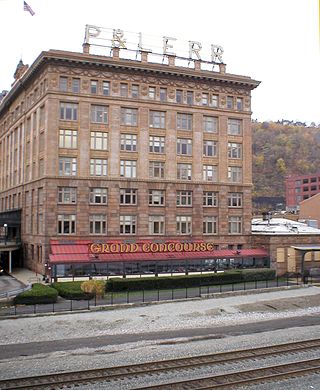
The Pittsburgh & Lake Erie Railroad Station, now Landry's Grand Concourse restaurant in Station Square Plaza in Pittsburgh, Pennsylvania, is an historic building that was erected in 1898. It was listed on the National Register of Historic Places in 1974.
The Plymouth Subdivision is a freight railroad line in the U.S. state of Michigan. It is owned by CSX. It connects the Plymouth Diamond at milepost CH 24.5 to Grand Rapids at CH 148.1, passing through the Lansing metropolitan area en route. Other towns served include South Lyon, Brighton, Howell, Fowlerville, Williamston, Grand Ledge, Lake Odessa, Clarksville, and Alto. Operationally, it is part of the CSX Chicago Division, dispatched from Jacksonville, Florida.

The Fort Street Union Depot was a passenger train station located at the southwest corner of West Fort Street and Third Street in downtown Detroit, Michigan. It served the city from 1893 to 1971, then was demolished in 1974. Today, the downtown campus of Wayne County Community College occupies the site.

Grand Rapids Union Station was a union station in Grand Rapids, Michigan. A Georgian Revival building of two stories, it was built in 1900 on 61 Ionia Avenue SW and was closed in 1958. The building was demolished in 1958 and 1959 to make space for the U.S. Route 131 highway.
